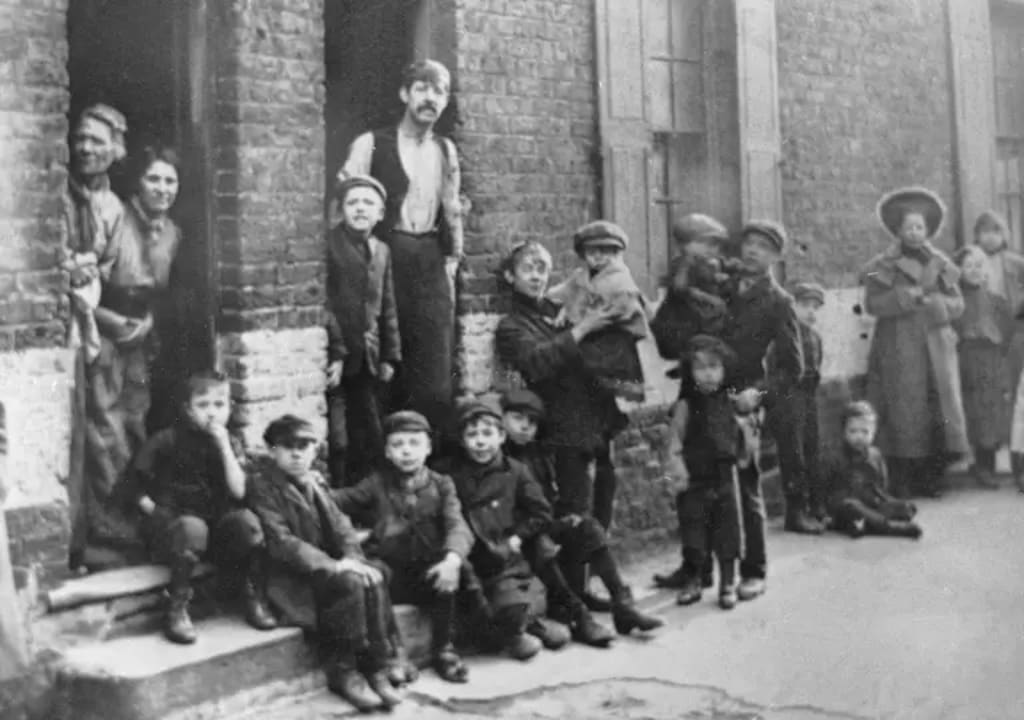SLUMS IN VICTORIAN LONDON
Too many people and too little space were the problems

The 19th century was the century of urbanisation, industrialisation and population explosion. Too many people and too little space were the problems.
Society changed from living in mostly rural communities to a society where most people lived in urban areas. In the time of Queen Victoria’s reign, Britain’s population had doubled. In 1851, for the first time in history, more people lived in cities than in rural areas.
The population growth caused many fresh problems that were most severe in the fast-growing cities, especially in London. In 1870, every eight minutes someone died in London and every five minutes a baby was born. This had to lead to space problems eventually, especially as the building industry did not consider the needs of the growing working classes in the cities.
There are records showing cases in which from three to four adults of both sexes, with many children, were lodging in the same room, and often sleeping in the same bed. In another location, a room was occupied by one man, two women, and two children; and in it was the dead body of a poor girl who had died in childbirth a few days before. The body was stretched out on the bare floor, without shroud or coffin. There it lay amid the living.
One of London’s most notorious slums by the end of the nineteenth century, Old Nichol Slum was in the east end, between High Street, Shoreditch, and Hackney Road in the north, and Spitalfields in the south. The slum was known locally as “The Sweaters’ Hell” for the artisan workshops, producing furniture for very low pay. The Nichol’s 30 streets housed around 5,700 people and had a death rate that was almost double that of neighbouring areas. A quarter of all children born in the Nichol died before their first birthday, and Old Nichol Street itself was described by a local medical officer, as being unfit for human habitation. Damp, overcrowding and the unwholesome air were largely to blame. But so was sheer despair.
In 1887, five out of every six infants to die in Bethnal Green homes where the entire family shared a bed were found to have suffocated. Coroners attributed most of these deaths to ‘overlaying,’ during which a sleeping parent or sibling rolled onto the infant and accidentally smothered it. Others, however, suspected that many were intentionally suffocated by desperate mothers with too many mouths to feed.
Records show, 85 Hanbury Street in the East End, was a house with nine rooms, all occupied by different families with an average of seven people in each room. The house had only one toilet, so people favoured the use of chamber pots, which is not surprising by an amount of around 63 people sharing one toilet. The problem was those pots often stayed in the rooms for long periods of time before they were emptied, which is also a reason the sanitary conditions were dreadful.
Another example shows Church Lane in Westminster, where the population living in a row of 27 houses grew from 655 inhabitants to 1,095 within six years. This means that the average number of inhabitants rose from 24 to about 41 per house.
In those days many people moved house repeatedly. Lord Shaftesbury estimated that around 70,000 people did not stay longer than 3 months in one place. Many of them left, leaving their waste, and went to another accommodation. Just as there were many people moving house frequently, there were many homeless. In 1887, the vestry of St. Martin-in-the-Fields had complained about hundreds of homeless sleeping on Trafalgar Square. Although people lived in the worst and most crowded housing, there still was not enough to house all the people in London, particularly affordable accommodation.
The most notorious slums were in East London, however, slums also existed in other parts of London, e.g. St. Giles and Clerkenwell, the Devil’s Acre near Westminster Abbey, Jacob’s Island in Bermondsey and Pottery Lane in Notting Hill.
The Victorian authorities were thrilled to hand over the problem of social housing to private landlords. These men and women – often from impoverished backgrounds themselves – were given free rein to control the districts in which they operated, with very little interference. They became the ‘godfathers’ of their territory, providing safe houses for criminals, operating brothels and running illegal gambling rackets. Any unwelcome attention from an over-zealous policeman was swiftly dealt with by bribes.
About the Creator
Paul Asling
I share a special love for London, both new and old. I began writing fiction at 40, with most of my books and stories set in London.
MY WRITING WILL MAKE YOU LAUGH, CRY, AND HAVE YOU GRIPPED THROUGHOUT.
paulaslingauthor.com






Comments
There are no comments for this story
Be the first to respond and start the conversation.